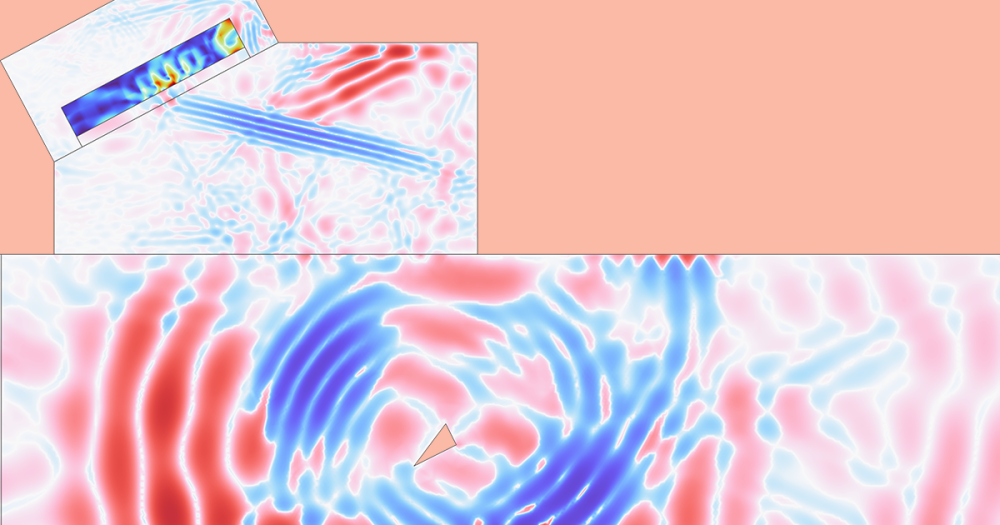
Hydraulic fracturing (popularly referred to as “fracking”) is a method to increase production of oil and gas from certain types of geological formations. It has been used for decades, but recently, as the practice has increased, fracking has become a controversial topic. I will avoid taking sides in this debate, but the fact that there is a conflict implies there needs to be a deeper understanding of the process and its effects.

Schematic showing orthogonal fracture propagation. From the paper “Investigation of Hydraulic Fracture Re-Orientation Effects in Tight Gas Reservoirs“. Image courtesy of B. Hagemann1 J. Wegner1 L. Ganzer1
1Clausthal University of Technology, Clausthal-Zellerfeld, Germany.
Putting Fracking under the Lens of Science
Fracturing is simple to describe; it’s just cracks in the earth. The mechanics involved, however, are complicated, especially when you consider fluid flow through formations within the earth. Moreover, it’s not easy to observe what’s happening hundreds or thousands of meters beneath the surface of the earth. These facts have made hydraulic fracturing a hot topic of active research, and since the underlying phenomena are relatively unknown, it is ideal for multiphysics simulation.
Lots of Research on Fracturing Presented at the COMSOL Conference
That fracturing is ideal for multiphysics modeling is evidenced by the number of papers and posters related to the topic presented at the COMSOL Conference earlier this year. Consider the following:
3D Modeling of Fracture Flow in Core Samples Using μ-CT Data, S. Hoyer1 U. Exner2 M. Voorn1 A. Rath3
1Department of Geodynamics and Sedimentology, University of Vienna, Austria
2Museum of Natural History, Vienna, Austria
3OMV ESG-D Production Geology, Vienna, Austria
Here the authors used CT scans of fractured samples of rock to perform simulations measuring permeability without destroying the samples — a difficult task using physical experiments.
3D Simulations of an Injection Test Done Into an Unsaturated Porous and Fractured Limestone, A. Thoraval1 Y. Guglielmi2 F. Cappa3
1INERIS, Nancy, France
2CEREGE, Aix-en-Provence, France
3GEOAZUR, Valbonne, France
The researchers behind this paper developed an advanced COMSOL model including stress-strain constitutive law, two-phase flows, and hydro-mechanical coupling, then applied it to an actual slope location in France.
A Coulomb Stress Model to Simulate Induced Seismicity Due to Fluid Injection and Withdrawal in Deep Boreholes, G. Perillo1 G. De Natale2 C. Troise2 A. Troiano2 M.G. Di Giuseppe2 A. Tramelli2
1University of Naples Parthenope, Naples, Italy
2INGV, Osservatorio Vesuviano, Naples, Italy
This paper presents a stress model to account for cases of fluid injection in deep boreholes, with particular application to a geothermal site in northeastern France.
Finite Element Solution of Nonlinear Transient Rock Damage with Application in Geomechanics of Oil and Gas Reservoirs, S. Enayatpour1 T. Patzek1
1The University of Texas at Austin, Austin, TX, USA
A novel script was written for a first-principles PDE model of rock damage until fracture.
Fracture-Matrix Flow Partitioning and Cross Flow: Numerical Modeling of Laboratory Fractured Core Flood, R. Sanaee1 G.F. Oluyemi1 M. Hossain1 B.M. Oyeneyin1
1Robert Gordon University, Aberdeen, United Kingdom
This paper is part of an effort to better understand subsurface flow that includes both fractures and matrix flow. Under certain stress conditions (fracture closure and overburden), the flow was studied and further physical experiments were suggested.
Investigation of Hydraulic Fracture Re-Orientation Effects in Tight Gas Reservoirs, B. Hagemann1 J. Wegner1 L. Ganzer1
1Clausthal University of Technology, Clausthal-Zellerfeld, Germany
Not just fracturing, but re-fracturing! This is an important consideration for tight gas formations where the critical question is: when should you perform re-fracturing for optimal productivity?
Poroelastic Models of Stress Diffusion and Fault Re-Activation in Underground Injection, R. Nopper1 J. Clark2 C. Miller1
1DuPont Company, Wilmington, DE, USA
2DuPont Company, Beaumont, TX, USA
Flow plus poroelastic deformation models developed in COMSOL point toward promising criteria for rock failure.
Concluding Thoughts on Fracking
No matter where you might stand on the issue, it’s great to see that COMSOL is enabling those who are at the forefront of fracture modeling to simulate, understand, and advance the technology. Knowledge, I think we can agree, is the key to understanding the risks and rewards of fracking.






Comments (1)
Li Chaeles
June 15, 2017Dear David,
This is an interesting topic. But it looks like there is lack of instructions on COMSOL’s application to geodynamic areas both online and in help documents. Is it possible the blog on Geomechanical topics could introduce some tips on how to model geological fault using contact node to simulate its movement?
Thanks!